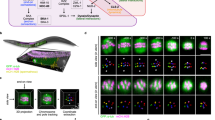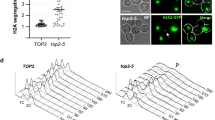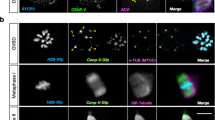Abstract
MANY authors have reported that the behaviour of univalent chromosomes at meiosis is irregular. At metaphase they tend to lie off the metaphase plate and closer to the poles than the bivalents; and it has been suggested that this is because the univalents move to the poles earlier. In the triploid species Leucopogon juniperinus univalents are close to the poles at metaphase, but serial sections show that they are not in the same plane as the spindle on which the bivalents are positioned (Fig. 1). Closer examination of the metaphase cells shows that the univalents are attached to a separate, much reduced spindle, which is attached to the same pole as the “bivalent” spindle but is formed in a different plane (Fig. 1, cells 2 and 3).
This is a preview of subscription content, access via your institution
Access options
Subscribe to this journal
Receive 51 print issues and online access
$199.00 per year
only $3.90 per issue
Buy this article
- Purchase on Springer Link
- Instant access to full article PDF
Prices may be subject to local taxes which are calculated during checkout
Similar content being viewed by others
References
Battaglia, E., Caryologia, 17, 1 (1964).
Hughes-Schrader, S., Chromosoma, 3, 257 (1948).
Kayono, K., Mem. Fac. Sci. Kyushu Univ. Ser. E (Biol.), 2, 53 (1956).
Ritushauser, A., Heredity, 10, 367 (1956).
Smith-White, S., Heredity, 9, 79 (1955).
Author information
Authors and Affiliations
Rights and permissions
About this article
Cite this article
FORD, J. Segregation of Univalents on Mini Spindles. Nature 229, 570–571 (1971). https://doi.org/10.1038/229570a0
Received:
Revised:
Issue Date:
DOI: https://doi.org/10.1038/229570a0
Comments
By submitting a comment you agree to abide by our Terms and Community Guidelines. If you find something abusive or that does not comply with our terms or guidelines please flag it as inappropriate.



